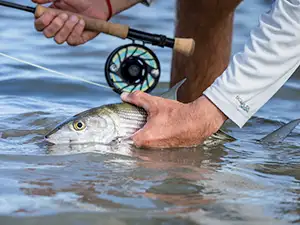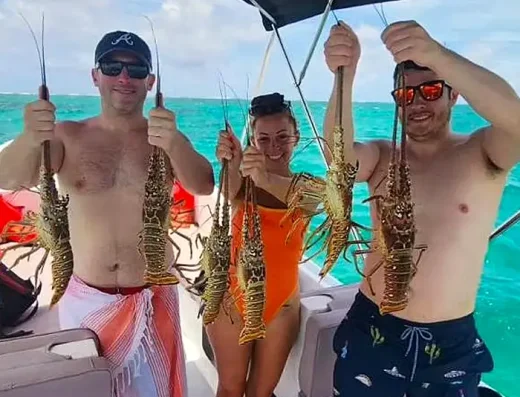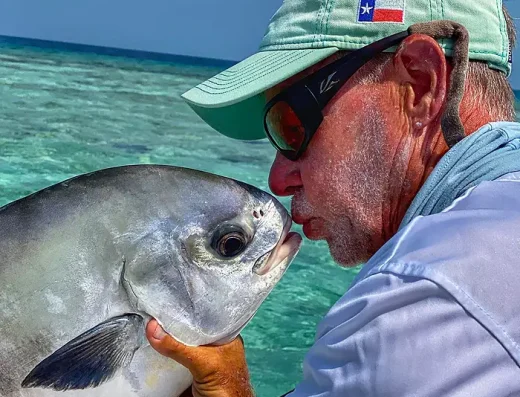Charter Fishing in Belize
Belize offers excellent fishing across offshore reefs, inshore flats, and freshwater rivers and lagoons.
Top Rated Charters in Belize
TrustedFish connects anglers with proven local captains in Belize —no commissions, no pay-to-play listings, no BS. Every charter on our platform is invite-only, vetted for skill, local knowledge, and reputation. If they’re listed, they’ve earned it.
Belize Fishing Guide
Belize’s fisheries are defined by its Caribbean coastline, barrier reef, atolls, and inland waterways. The Belize Barrier Reef, second only to Australia’s, runs the length of the coast and shelters countless reef species, while its drop-offs hold pelagics like wahoo, tuna, and marlin. The flats inside the reef and around cayes such as Ambergris Caye, Turneffe, and Glover’s Reef are famous for permit, bonefish, and tarpon, making Belize one of the premier destinations for saltwater fly fishing. Rivers and lagoons in the interior hold snook, tarpon, and various freshwater species, providing year-round fishing diversity.
Seasonal bite patterns shape the country’s reputation. Spring and summer bring strong tarpon migrations, with fish ranging from juvenile size to giants over 100 pounds. Bonefish and permit are present all year but feed more aggressively with warmer water and moving tides. Offshore, tuna, dorado, and marlin follow summer currents along the reef edge. Fall brings calmer seas and good reef fishing for snapper and grouper, while winter is peak for wahoo and barracuda offshore, and flats fishing remains steady with permit and bonefish in cooler shallows.
Belize’s charter industry is well developed, centered in San Pedro, Placencia, and Belize City. Half-day trips typically target reef species—snapper, grouper, jacks—while full-day trips head offshore for pelagics or stalk tarpon and permit on the flats. Multi-day liveaboard mothership trips are popular around Turneffe Atoll, combining diving and fishing. Boats range from small skiffs built for shallow flats to larger offshore craft rigged for trolling.
Techniques vary with location: fly fishing dominates the flats, especially for bonefish, permit, and tarpon. Spin anglers use jigs, live bait, and plugs for snook, barracuda, and reef species. Offshore boats troll lures and baits for wahoo, tuna, and marlin, while bottom fishing with cut bait produces grouper and snapper. Jigging and vertical fishing are also used around reef edges and drop-offs. Anglers in Belize adapt constantly, as conditions shift daily with tides, wind, and currents.
Fishing Seasons in Belize
Spring
This is prime time for flats fishing. Tarpon begin migrating in larger numbers, while bonefish and permit feed aggressively on warming flats. Offshore, dorado and tuna become more consistent along the reef edge. In rivers and lagoons, snook and smaller tarpon also stay active. Fly fishing is at its peak, with sight casting opportunities daily.
Summer
Tarpon fishing peaks, with big migratory fish cruising the coasts and atolls. Permit are also strong, especially around Turneffe and Glover’s Reef. Offshore, blue marlin, yellowfin tuna, and dorado are prime targets, with trolling trips running from coastal towns. Reef fishing for snapper and grouper remains steady, making summer the most diverse season overall.
Fall
Calmer seas make reef and flats fishing productive, though offshore pelagics taper slightly. Permit remain a strong target, and bonefish are plentiful. Tarpon are still caught, though fewer migratory giants are present. Grouper and snapper fishing picks up, and barracuda become more aggressive in cooling waters. Anglers use a mix of bait fishing and light tackle casting.
Winter
Offshore fishing peaks for wahoo, barracuda, and sailfish, with trolling producing big runs. The flats remain consistent for bonefish and permit, though cooler water slows tarpon. Reef fishing is excellent, with snapper, grouper, and jacks biting steadily. Rivers and lagoons provide good options for snook and juvenile tarpon. Light spinning gear and trolling rigs dominate this season.
Top Fishing Regions
Ambergris Caye & San Pedro
Belize’s most famous fishing destination, with easy access to both the flats and the reef. Flats hold bonefish, permit, and tarpon year-round, while offshore boats troll for dorado, tuna, and marlin in summer, and wahoo in winter. Skiffs and local guides make San Pedro a hub for fly anglers worldwide.
Turneffe Atoll
This atoll is legendary for permit and bonefish, with tarpon also frequenting channels and lagoons. It’s a premier fly fishing location, accessible by day trip or liveaboard. Offshore edges also hold wahoo and tuna during peak seasons, giving anglers multiple options.
Placencia
A southern hub with access to both flats and offshore fishing. Permit and bonefish are common on nearby cayes, while offshore charters chase tuna, dorado, and wahoo. The area is less pressured than Ambergris, offering a quieter but equally productive fishery.
Belize City & Barrier Reef
From Belize City, charters run to the Barrier Reef and nearby cayes. Reef fishing for snapper, grouper, and barracuda is strong, while offshore boats troll pelagics in summer and winter. The city’s location makes it a starting point for both day trips and multi-day excursions.
Southern Rivers & Lagoons
Rivers and lagoons south of Dangriga and Punta Gorda are prime for snook and juvenile tarpon. These waters are productive year-round, with fly anglers and spin fishermen both finding success. This region is more remote, appealing to those seeking solitude.
Top Gamefish in Belize
- Tarpon – 20 to 150 lb. Found in rivers, lagoons, and coastal flats, peak from May through September, targeted by fly fishing, live bait, and plugs.
- Permit – 5 to 30 lb. Present year-round on flats, strongest spring through fall, pursued with fly gear and crab patterns or live crabs.
- Speckled Trout – 12 to 24 inches. Most active spring through fall. Drifting or casting live shrimp under corks or soft plastics near grass and current.
- Bonefish – 2 to 8 lb. Found year-round in shallow flats, best in spring and fall, caught on flies and light spinning tackle.
- Snook – 5 to 20 lb. Common in rivers and lagoons, active during cooler months, taken with live bait, jigs, and plugs.
- Grouper – 5 to 40 lb. Found on reefs and drop-offs, productive year-round with cut bait and jigs, best in cooler months.
- Dorado (Mahi-Mahi) – 10 to 30 lb. Offshore in summer months, caught by trolling lures and ballyhoo
- Tarpon – 30 to 200 lb. Florida, Gulf Coast; late spring to summer; live bait drifting or sight casting.
- Halibut – 20 to 300 lb. Alaska and Pacific Coast; summer and fall; bottom fishing with bait or jigs.
Belize Fishing FAQs
Do I need a fishing license in Belize?
Yes, a sport fishing license is required for both residents and visitors. Licenses are available online or through local tour operators.
What is the best time to fish in Belize?
Summer is best for tarpon and offshore pelagics, while winter peaks for wahoo and reef fishing. Bonefish and permit are available year-round.
Where are the most popular fishing spots in Belize?
Ambergris Caye, Turneffe Atoll, Placencia, and Belize City are the main hubs, each offering access to flats and offshore waters.
How long are typical fishing trips?
Half-day trips often target reef or flats species, while full-day trips allow offshore trolling or multiple flats stops. Multi-day liveaboards run around the atolls.
What gear should I bring for fishing in Belize?
Fly anglers bring 8–12 wt rods for bonefish, permit, and tarpon. Spin anglers should pack light tackle for flats and heavier setups for offshore trolling.
Are there catch-and-release rules in Belize?
Yes, bonefish, permit, and tarpon are strictly catch-and-release by law. Other species like snapper and grouper may be kept within size and bag limits.
Is Belize fishing family-friendly?
Yes, reef trips for snapper, grouper, and barracuda are well-suited to beginners and families. Flats trips require more patience but guides adjust for skill levels.
Can I fish from shore in Belize?
Yes, shore fishing is possible along beaches and docks, especially for barracuda, snapper, and bonefish. Access is easier on the cayes than on the mainland.
How much does a charter cost in Belize?
Half-day reef trips often cost around $250–$350 for two anglers, while full-day flats or offshore trips range $400–$700. Multi-day liveaboards are higher.




